![]()
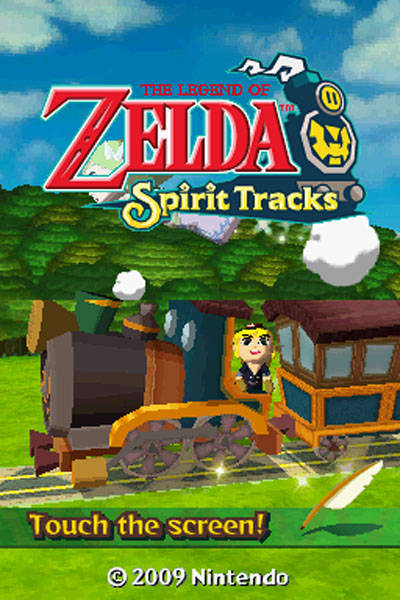
This might just be the most objective review of The Legend of Zelda: Spirit Tracks ever written. That’s because I’m not so in love with any of the other Zelda games that I’m extra-critical or extra-forgiving of a new installment. Yeah, that’s right—I said I’m not a big fan of the Zelda games. Ready your hate-mail cannons.
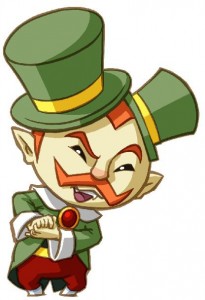
Spirit Tracks resides in the same timeline as Phantom Hourglass and Wind Waker before that, taking place several decades later in a futuristic world where everybody rides around on sophisticated steam-powered trains, yet they still fight with spears and haven’t invented flush toilets.
The visual style is the same cartoony 3-D we’ve all come to know and argue about, and the plot is pretty standard for a Zelda game—visit a series of themed dungeons in a quest to keep some foul evil from being loosed on a world that takes unpleasantly long to traverse.
As with Phantom Hourglass, Link is controlled exclusively using the stylus: point at the spot to where you’d like Link to move, sweep in front of him to swing your sword, and tap on people to make them wastefully blather at you.
There, I just covered all the basic info about the game in a single paragraph. That’s impressive; I’m rarely so concise. There’s at least two or three people out there who had kids and retired before they finished my review of Mega Man 10. Let’s just hope I don’t blow it by bloating this review with random tangents.
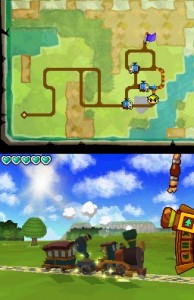 Whereas—from a gameplay standpoint—Wind Waker is essentially a normal Zelda game with a higher emphasis on exploration, and Phantom Hourglass is a refinement of Wind Waker that experiments with the split-screen, touch-sensitive, multiple-input possibilities of the Nintendo DS, Spirit Tracks is a mildly creative rehash of Phantom Hourglass featuring two minigame-worthy gimmicks blown way out of proportion. The first gimmick is, of course, the use of a train.
Whereas—from a gameplay standpoint—Wind Waker is essentially a normal Zelda game with a higher emphasis on exploration, and Phantom Hourglass is a refinement of Wind Waker that experiments with the split-screen, touch-sensitive, multiple-input possibilities of the Nintendo DS, Spirit Tracks is a mildly creative rehash of Phantom Hourglass featuring two minigame-worthy gimmicks blown way out of proportion. The first gimmick is, of course, the use of a train.
To get absolutely anywhere, Link—who is an engineer-in-training (sorry; couldn’t resist)—must ride his little choo-choo from station to station. Being that this isn’t Back to the Future and trains can’t fly through the air, you are resigned to following the same accursed length of track from one place to another until you progress enough to unlock other accursed lengths of track that may, in fact, make the trip longer.
The switch from a boat to a train as Link’s primary mode of overworld transportation is like starting Final Fantasy with an airship and then downshifting to a canoe, which is precisely why Spirit Tracks offers more to keep you busy while spending eternity getting from A to B—and that’s precisely why everything you do between towns and dungeons feels like an overgrown minigame.
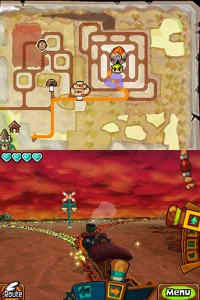 In-transit activities include tooting the horn to pass the time, spinning the camera around wildly to find out what’s firing at you after you’ve dozed off, shooting listlessly at sporadically placed boulders, checking your watch, and traveling through Stargate-inspired portals that teleport you to whatever location is farthest away from your intended destination.
In-transit activities include tooting the horn to pass the time, spinning the camera around wildly to find out what’s firing at you after you’ve dozed off, shooting listlessly at sporadically placed boulders, checking your watch, and traveling through Stargate-inspired portals that teleport you to whatever location is farthest away from your intended destination.
If you’re carrying passengers (an ever-popular sidequest), you must carefully follow the signs that dictate whether you should slow down, speed up, blow the whistle, or forget the whole thing and play Link to the Past instead.
Train travel reaches the height of gimmickry when evil trains start appearing on the tracks that roam around in circles, block your path, chase after you, and destroy you in one hit. As a one-time challenge, this’d be fine, but you have to deal with this almost every time you disembark.
Not to spoil anything, but the final train voyage of the game begins with a setup involving invincibility power-ups and these devious enemy trains, which crosses the line into a new game altogether: The Legend of Pac-Man: Spirit Pacs. I kid you not.
The other major gimmick is one that is morally offensive the world over: escort quests. You discover early on that the Big Bad Guy wants Princess Zelda for her body, and her spirit gets kicked out and has to accompany Link everywhere as the latest incarnation of Obnoxious Things That Follow Link Around And Tell Him What To Do.
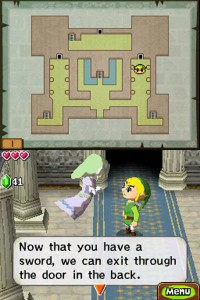
As a spirit, Zelda has the power to possess the heavily armored Phantom enemies that appear in about half the dungeons you’ll visit, and as the product of an era of gaming that has yet to master fully competent teammate AI, she will frequently get stuck in a corner and shout at you for attention until you feed her, play with her, and clean up—no, wait; that’s a Tamagotchi.
Perhaps “escort quest” isn’t the right term for the gimmick, but Zelda’s not exactly a team player: she does virtually nothing but tag along unless you tap her with the stylus and drag her across the room to an object she can interact with or a location where she’d be more useful. (For example, not standing directly in your way. AGAIN.)
This system works well for simple puzzles such as having Link and Zelda stand on two different switches to open a door (though Zelda always botches this by overshooting the switch and standing next to it). Unsurprisingly, more complex challenges such as riding Zelda down a hallway and forcing her to distract the guards with her Phantomine wiles are trickier to execute because the game doesn’t pause as you give her commands, and failure almost always involves significant backtracking and occasional colorful language.

Despite the introduction of new ways to use your train and your princess as the game progresses—a freight car is added to your train so you can haul chickens and other precious cargo, and new varieties of Phantoms who can teleport or SET THINGS ON FIRE come into play—these central gameplay elements start growing wearisome before the game is even halfway through.
It’s a breath of fresh air to step into a dank, smelly dungeon with no Phantoms to possess, but even then, too many of the enemies and puzzles are ripped from Phantom Hourglass with, at best, enough variation to feel like something out of an expansion pack rather than a brand-new game.
Worse yet, the dungeon rooms all start to look the same after a while, and the uncharacteristically repetitive soundtrack does little to help the situation. Also, the uncharacteristically repetitive soundtrack does little to help the situation.
By the time I was at the entrance to the final area of the game, there were still many sidequests left to complete. Passengers needed to be ferried to places I’d never heard of! Bunnies needed to be snatched out of their natural habitats and thrown into a zoo! An urgent chicken shipment was due in the next map over!
There were hidden treasure chests and uncharted dungeons and upgrades to my train that I had yet to see, but neither my curiosity nor my enjoyment of the game negated the tedium of endless train travel any longer. If the teleportation portals were placed in more convenient locations, if there was more to look at while riding the train, and if there was a speed upgrade that allowed your train to outrace the creeping boredom associated with continuous linear travel, I might not have given up so soon.
Of course, I almost gave up a lot sooner after nearly passing out from an hour of blowing on my DS, as though it were about to catch fire. The first two items you receive require you to blow into the DS microphone to use them, and they are absolutely the only items you have in your inventory for quite some time.
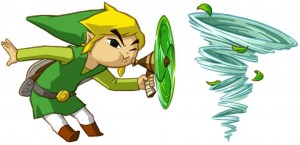
Spirit Tracks is not a game to play in public if you’re self-conscious: in addition to all the blowing, you may need to frantically scribble on the touch pad and spontaneously shout the word “CUTE!” into the microphone a few times. This is how Spirit Tracks appears to an outside observer:
“PFFFT!!! PFFFT!!! [tap tap tap] PFFFT!!! [tap squiggle squiggle tap] CUTE!!! [stroke stroke scribble tap] PFFFT!!!”
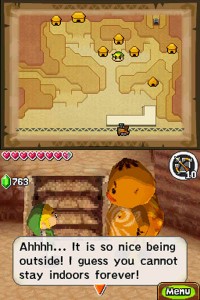
Yeah, that might be cause for concern. Though, one might argue, getting caught playing Link Rides a Choo-Choo Train in public might also be cause for concern. Not that I’d ever refer to the game by that name in a professional review.
Link Rides a Choo-Choo Train has some fun and creative sections, but it’s hard to make a case for thoroughly beating the game if you’re anything but a die-hard Zelda fan.
The train is more of a novelty than anything else; the only lasting enjoyment I got out of riding the train was from suddenly slamming on the brakes to pull into a station with sparks flying and wheels screeching.
Babysitting Phantom Princess Zelda opens up some interesting puzzle possibilities, most of which are more fun in theory than in practice.
Most of the special items are entertaining (if you’ve got the lung capacity), though a few didn’t get quite as much air time as they deserved, and the ones you’ve seen before will need a revamp if they’re to stay fresh in future sequels.
Whether rehashed from previous games or all-new, the vast majority of challenges left me saying, “Really? Do I have to do that?”
I appreciate the feeling of continuity stemming from the references to Phantom Hourglass and Wind Waker, and I got a few good laughs out of Zelda’s paranoia concerning her out-of-body experience, but the story sequences tend to get a little long-winded (must be all that blowing).
I do give the game credit for having one of the most satisfying Zelda endings I’ve ever seen, but that could be entirely related to the fact that I had just beaten the game and could finally put it away forever.
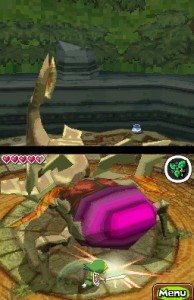
I could go on about all the finer details, but here’s the bottom line: Spirit Tracks would be more enjoyable if it didn’t have the pressure and expectation of living up to the Zelda name. My suspicion is that Spirit Tracks is best enjoyed as one of your first forays into the Zelda series, before you know any better—especially if you haven’t played the notably similar Phantom Hourglass, or unless you did play it and just hated rowing a boat all over creation.
Spirit Tracks isn’t a bad game; it’s just not a great Zelda game, and I had to spend too much time doing things I didn’t want to do in order to get to the parts I wanted to play. In this case, the parts I wanted to play were in different games entirely.
Nah, I jest. A little. Spirit Tracks is a decent way to pass the time on a long trip, it offers a lot of replay value for the die-hard fan, and it’s good conversation fodder, but, to borrow a quote from the footmen in Warcraft II, I’d rather be sailing.

The special items didn’t get as much AIR time as they deserved, ha!
And they didn’t get rid of the phantom challenges? Darn. That was the part of Phantom Hourglass that caused me to stop playing.
The phantom challenges are different. You still have to collect Tears of Light to power up your sword, and you still have to hide on the glowy floors if they chase after you, but there’s no time limit, and avoiding them isn’t as miserable as before because it takes less time to power up the sword, and you’ve got Zelda to help you then.
Also, you don’t need to replay the same dungeon over and over; there’s still a central hub like the main temple in PH, but the backtracking is minimal.
Well good, that sounds better. But actually, I think what killed the game for me in the phantom dungeon was the “draw a triforce” challenge, which took me over twenty minutes to complete, because apparently, if you don’t draw the six lines in a certain order, the game won’t accept it. Phooey!
Funny review. I wonder if some game developers put in irritating enemies or characters simply out of boredom.
Thanks, John! I think it’s probably more likely that developers say, “Hey, THIS sounds like a fun idea!” but never bother to playtest it before it’s too late.